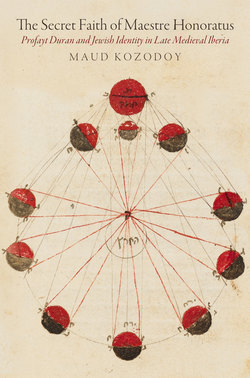Читать книгу The Secret Faith of Maestre Honoratus - Maud Kozodoy - Страница 8
На сайте Литреса книга снята с продажи.
ОглавлениеPART ONE
An Intellectual Portrait
Against a decidedly mixed background of prosperity and adversity, Jews in the Crown of Aragon enjoyed a brilliant and vigorous intellectual life throughout the fourteenth century—and the wealthiest and most cosmopolitan part of the Crown was Catalonia, in particular the royal seat of Perpignan. There, Jews excelled in the practice of medicine and composed works of philosophy, literature, exegesis, and more. The Jewish “intellectual effervescence”1 of this period was open to many different traditions and strains, with Arabic-influenced philosophical rationalism thriving alongside kabbalah and the Talmudic scholarship of northern France. Other strong elements in the elite culture of rationalist Iberian Jews were the secular sciences, especially astronomy;2 in the fifteenth century, the most important astronomer in the Iberian Peninsula was the Jew Abraham Zacut (1452–1510) of Salamanca.3 Iberian and Provençal Jews were often also to be found as master clockmakers and as manufacturers and repairers of scientific instrumentation for the court. Mallorcan Jews, for their part, were involved in royal mapmaking, the most well known being the map illustrators Abraham and Jafudah Cresques.4
As noted in the Introduction, Profayt Duran’s own scientific activity is of interest not only for the light it can shed on Jewish identity but also for what it can tell us about the transmission of science outside the orbit of the university. It has long been thought that Iberian science was relatively “backward” by the standards of other European centers. But as recent research has shown, that is a misapprehension.5 Iberian universities were indeed weak in comparison with those of northern Europe, but they were not where the practice of science primarily took place. Jews, in any event, were excluded from the universities, although they had access to Hebrew translations of some of the texts being studied there. In examining how Duran taught subjects like mathematics and astronomy, we can thus grasp how science in general might have been transmitted in a nonuniversity context in Iberia. In interpreting this material, we will also gain insight into the role of court patronage and into the practical orientation of the science promoted in the service of the Aragonese kings. Finally, in observing the multiple contexts in which scientific information was conveyed, we should also arrive at a deeper understanding of the ties that bound together the tiny circle of the Jewish intellectual elite.
In many ways, as a member of this urban Jewish elite, Duran was utterly unexceptional. His education and background were, as we will see, fairly standard for his social class. He was both a moneylender and a physician, the two most prevalent professions among the Jews of late medieval Iberia and two that were often combined. His primary scholarly interest—astronomy—was the most commonly studied scientific field among medieval Jews in general. His fundamentally rationalist and yet relatively moderate attitude toward philosophy and its late medieval Jewish avatar, Maimonides, took the middle ground in the contemporary spectrum of philosophical positions.
In another respect, too, his case was “typical,” or at least seemingly so: although (as mentioned earlier) we do not know the precise circumstances of his conversion to Christianity, we do know that in 1391—like many others—he was compelled to accept publicly a religion he rejected inwardly. And yet one fact sets Duran apart from others of his generation. Instead of quietly making his individual way in the world, he wrote works that reveal his intense inner commitment to remaining a Jew. Through those works, we have an unusual and highly illuminating opportunity to glimpse not only the compromises that might enable someone like him to live for decades as a Christian but the informed and polemically forceful theological justifications of his continued self-identification as a Jew.
To understand how he came to make the decisions he did, it helps first to rehearse what we know of his life and intellectual milieu. The next few chapters thus trace Duran’s biography, his professional life and teaching activities, and his basic philosophical orientation.
